New Approach to Low-Level Offenses is Working
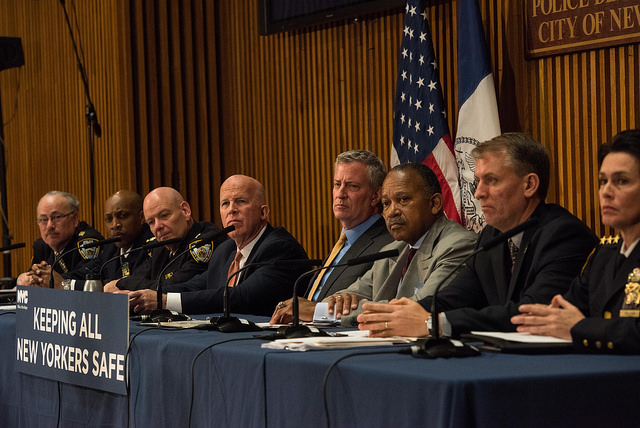
(photo: Michael Appleton/Mayoral Photography Office)
How should police respond when someone is drinking a beer in the street, dropping litter, or engaging in other minor offenses? Up until a year ago, a criminal summons was the only answer, and if the person didn’t show up in court, he or she could be arrested on a warrant.
As a result, New Yorkers had as much contact with the system for low-level offenses as for serious crimes.
Consider that in the first half of 2017, there were 112,000 criminal summonses compared to 98,000 misdemeanor arrests and 50,000 felony arrests. The summonses practice had a snowballing effect on the justice system: over its history of this practice, many people failed to take a day off of work or find the time to settle the criminal summons.
More than a million warrants accumulated.
Last year, that all changed.
In city legislation called the Criminal Justice Reform Act (CJRA)—passed by the City Council under then-Speaker Melissa Mark-Viverito and signed by Mayor Bill de Blasio—police now have the option to issue a civil summons instead of a criminal summons, which can be handled like a ticket in the city’s administrative law court, the Office of Administrative Trials and Hearings, known as OATH.
Under the CJRA, if the summons is filed at OATH for the hearing, the punishment is a fine. If a court date is missed, it does not result in a warrant and arrest like it could in criminal court.
And if found in violation after a hearing, the option is available to pay the fine or do community service. Community service at OATH is instructive and aimed at preventing future offenses instead of solely requiring the performance of menial tasks.
The effect of the law has been dramatic.
Since June 2017, criminal summonses and warrants for CJRA-eligible offenses are down 89 and 94 percent, respectively. Over the same period, serious crime fell 13 percent.
Warrants issued for failure to appear in court for a small set of low-level offenses—for example, drinking in public, entering a park after dark, unreasonable noise, and public urination—could reach as high as 5,000 in a single month. Now they are around a few hundred.
During this time, the Mayor's Office and the City Council also worked with the NYPD, district attorneys, the courts and other partners to clear more than 644,000 warrants for minor, non-violent offenses that were 10 years old or older.
There are, of course, exceptions to the new enforcement option for low-level offenses. Someone may still be directed to criminal court if he or she has two or more felony arrests in the past two years, has three or more unanswered OATH summonses in the past eight years, is on probation or parole, or if there is another legitimate law enforcement reason.
The success of CJRA is not just that police now have more options. Nor is it just that there is more proportionality in how we enforce the laws, though that is important. It is also that more people are attending to their summonses.
In May of 2017 appearance rates on criminal summonses were at 64 percent. In April of 2018 that number had risen to 71 percent—which is also a credit to the multiple partners, courts, police, district attorneys, and others who helped develop a redesigned summons form, to make directions more clear, and sending text message reminders that alert people of their upcoming court dates.
Enhanced appearance rates are not happenstance. One thing we know well, both from research and from everyday experience, is that people are more likely to obey the law when they believe that they are treated fairly and that the system is responding appropriately. When the punishment for low-level offenses is out of step with the seriousness of the offense, New Yorkers lose confidence in the fairness of the system as a whole and are less likely to comply.
It is one reason why the NYPD had already been issuing fewer criminal summonses even before the CJRA, considering new approaches to low-level offenses, and has expanded neighborhood policing, which emphasizes building partnerships with the community.
We do not know for sure whether this is the dynamic that is changing behavior but we have asked the Misdemeanor Justice Project at John Jay College of Criminal Justice to do an evaluation of the effects of the CJRA and hope to learn more in the year ahead.
We know this will not fix everything. Racial disparity still persists and we have work to do. However, this dramatically lightens the volume and weight of the system’s touches on New Yorkers who commit low-level offenses.
We are hopeful that this approach that relies on residents to live cooperatively with their neighbors while ensuring compliance through proportionate measures will create a virtuous cycle in which rules are followed because they are fair and just.
***
Elizabeth Glazer is the Director of the New York City Mayor’s Office of Criminal Justice. On Twitter @CrimJusticeNYC.
***
Have an op-ed idea or submission for Gotham Gazette? Email This email address is being protected from spambots. You need JavaScript enabled to view it.
Reimagining the Brooklyn Democratic Party
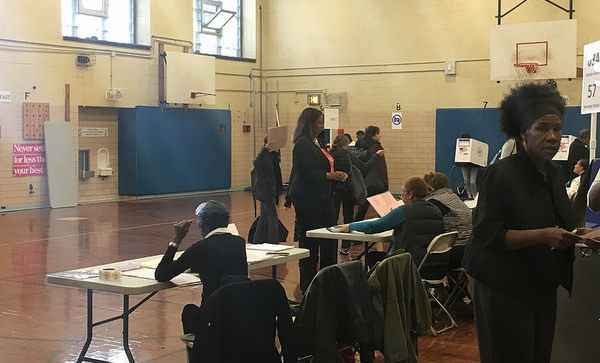
(photo: Gotham Gazette)
The New York Times recently published a story about the Queens Democratic Party and how it stacked its Democratic County Committee with at least 21 people who had no idea that they were running for the position. One of the “candidates” actually lived in Florida. The Times article said, in part: “it is not entirely clear why the party would want to populate the committee with people who did not know they were on it.” In Brooklyn, it is totally clear.
For background, the Kings County Democratic Committee has a general membership of approximately 3,000 people. Every two years, in the September primary, each Assembly District elects both a male and female District Leader (officially called a “Member of the State Democratic Committee”). Collectively, the District Leaders make up the executive committee of the Brooklyn Democratic Party.
Like Queens, the general membership of the Brooklyn Democratic Party is filled with people who are unaware they are party officials or who have no interest in serving the Party. The leadership of the Brooklyn Democratic Party exploits this ambivalence by holding County Committee meetings in hard to reach locations, inaccessible by public transportation, and then telling members that they can skip the meeting if they give the County Chair their proxy votes.
By collecting proxies from uninterested or unaware members, the Party leadership gets the votes they need to maintain full control over the direction and agenda of the Party. It gives the Party leadership the numbers it needs to beat back any reform efforts and to deny grassroots Democrats a voice in the selection of the Democratic nominees for State Supreme Court or to fill a legislative vacancy.
The specific problems that exist in Queens have somewhat receded in Brooklyn. To his credit, when Frank Seddio took over as Chair of the Kings County Democratic Party, he agreed to adopt incremental reforms being pushed by the Brooklyn Reform Coalition. Many of these reforms are the ones that Queens reformers are still fighting for today. While there has been some improvement, Brooklyn still has a long way to go.
In the short term, the Brooklyn Democratic Party must end proxy abuse. No person, whether the County Chair, a District Leader, or a general member, should be allowed to hold more proxies than the number of County Committee members serving in their Assembly district.
Likewise, the Party currently will only pay for the County Chair to send a proxy solicitation to all members of the County Committee. District Leaders have no budget and lack the financial resources to individually send a similar solicitation. This imbalance can be cured by allowing proxies to be submitted electronically or by the Party funding a mailing for each and every District Leader who wants to solicit proxies.
The long-term goal, however, is to end governance by proxy.
There are over 1 million Democrats in Brooklyn. Certainly we can find a few thousand who are committed to building a vibrant, transparent, and inclusive Brooklyn Democratic Party. Every board or committee I have ever sat on had a rule against missing too many meetings. The same needs to be true with the Brooklyn Democratic Party. At the same time, to ensure a diverse and inclusive party, meetings need to be held at a variety of times and locations so that no one is excluded due to a serious obligation, such as working at night or childcare responsibilities.
All over the country, local Democratic Parties are vibrant, active, and impactful. They meet regularly, have subcommittees with important party-building responsibilities, and develop and promote a political platform. Brooklyn is the largest local Democratic Party in the country and does none of these things. Instead of being national leaders, we are lagging far behind. Implementing the reforms I’ve outlined here will allow us to grow into a national model of what a fighting Democratic Party can accomplish.
These are not revolutionary ideas. This is what local Democratic Parties do all over the country. Once Brooklyn’s rank-and-file Democrats demand these changes, these ideas will be impossible to stop and we will finally have the Democratic Party that Brooklyn wants and deserves.
***
Doug Schneider is a candidate for Member of the Democratic State Committee/District Leader in the 44th Assembly District in Brooklyn. On Twitter @DougSchneiderBK.
***
Have an op-ed idea or submission for Gotham Gazette? Email This email address is being protected from spambots. You need JavaScript enabled to view it.
Labor’s Unsung Heroes

(photo: The Governor's Office on flickr)
A tribute to America’s workers, Labor Day has evolved beyond a day of parades and festivals duly celebrating the achievements of workers to one emphasizing the economic realities and civic significance of the unsung heroes responsible for the prosperity of our country.
Of these everyday heroes, no one is more unsung than the women of color and immigrant women who, in the main, bear the responsibility for raising their families while at the same time working outside the home.
All groups of women earn less than white males across communities and job categories, but the discrepancies vary greatly by race and ethnicity. White women earn 84 cents for every dollar earned by white men, Asian women earn 63 cents, black women earn 55 cents, and Latina women earn 46 cents. To put it in perspective, given the current pay gap, black women must work about an additional 200 days to make what white men earn in a year.
Here in New York, women of color and immigrant women form the bedrock of the labor force. They are frequently both the main or sole caregivers and main or sole wage earners in their households. They supply the bulk of the paid caregiving services, on which so many other New York households depend and account for a major share of the retail and restaurant sector workforce that drives our economy.
Yet the progress of women of color and immigrant women has not historically been a top priority for anyone, even philanthropies. Less than 7% of foundation funding goes directly to supporting programs for women and girls.
Today, there are determined, grassroots organizations forging strong approaches to expanding the economic security and well-being of women. The Business Center for New Americans and the Damayan Migrant Workers Association provide shining examples.
The Business Center for New Americans promotes the American dream of financial independence and home ownership, providing refugees, immigrants, women, and other New Yorkers with the information, counsel, and support needed to thrive financially. They advance entrepreneurship through microlending, combined with training and technical assistance, and homeownership through down payment assistance, training, and access to incentives.
The Damayan Migrant Workers Association empowers low-wage workers to fight for their rights by building leadership at the grassroots level to eliminate labor trafficking, fight labor fraud and wage theft, and to demand fair labor standards to achieve economic and social justice.
The New York Women’s Foundation is proud to support and salute these organizations, and our other grantee partners in this space, for their efforts to secure a better future for the thousands of women of color and immigrant women in our workforce. They, and those they assist, are our heroes on Labor Day and every day.
****
Camille Emeagwali is vice president of programs at The New York Women’s Foundation.
***
Have an op-ed idea or submission for Gotham Gazette? Email This email address is being protected from spambots. You need JavaScript enabled to view it.
Remembering John McCain, Campaign Finance Reformer
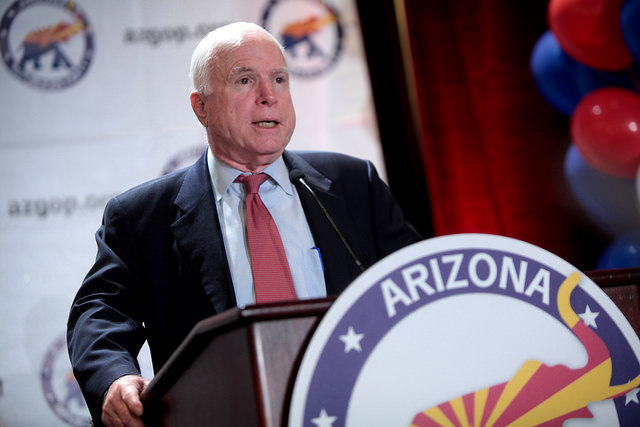
Late Senator John McCain (photo: Gage Skidmore)
There are precious few genuine heroes left in public life in America. That’s why the passing of John McCain last weekend felt like such a huge loss for many of us whose lives are devoted to the practice of politics and government.
Despite his flaws, Senator McCain leaves behind a deep and unique imprint on American history. Among his most important legislative achievements was the enactment of the most significant national campaign finance reform measure since the post-Watergate years.
As a young press secretary to Congressional Rep. Christopher Shays (R-CT) in the late 1990s, I had the opportunity and privilege to work with Senator McCain and his staff as part of the legislative coalition fighting for reform on Capitol Hill. Though there were many good men and women whose efforts were necessary for success, there was no question who was leading the charge.
The issue of reform was a personal one for McCain. As one of the “Keating Five,” he was rebuked by the Senate for exercising poor judgment in meeting with bank regulators on behalf of Charles Keating, a long-time campaign donor and chair of a failed savings and loan institution. McCain described the incident as a low point in his career. He openly admitted his mistakes, apologized to his constituents, and began a relentless push to transform the campaign finance system.
The proposition that McCain and his colleagues advanced was a simple one: the same laws that applied to the way that candidates raise funds should apply to political parties and other campaign groups. No more corporate shakedowns for the party leaders—they would need to follow the same “hard money” restrictions as candidates. Interest groups trying to swing elections with campaign commercials disguised as “sham” issue ads (i.e. “Call Senator Smith and tell him to keep his hands off our guns”) would have to play by the same rules.
This was a stance that put him in direct conflict with the leaders of his party—Trent Lott and Mitch McConnell in the Senate, and Tom DeLay in the House—who collected the dough and held the purse strings. The McCain-Feingold legislation was a direct threat to their way of doing business.
Party leaders on both sides routinely approached corporate leaders for six-figure donations, often as they were considering Congressional action on their priorities. They distributed the proceeds to help their colleagues in close races. By withholding campaign funds, they could—and often did—exact retribution on those who stepped out of line.
The forces arrayed against the reform effort were powerful. Unlike today, there was no urgency from the grassroots in either party to address the corrosive power of money in politics.
Yet through the sheer force of personality and will, McCain pushed reform onto the national agenda. I recall long-serving members of Congress, as cynical as they come, whose faces would light up like school-kids in the presence of the senator from Arizona. Invariably, they would leave our coalition meetings giddy to follow him into battle.
The Bipartisan Campaign Reform Act (BCRA)--known as McCain-Feingold after the bill’s sponsors--took an extraordinary route to passage, one that seems no longer possible in today’s hyper-partisan environment. In the House, dozens of Republicans joined their Democratic colleagues to sign their names to a discharge petition that forced the bill onto the floor against the wishes of Speaker Dennis Hastert. In the Senate, 11 Republicans joined with the Democratic caucus to give the bill a filibuster-proof majority.
In taking on their party leadership, many of the moderate Republicans at the time were embarking on what could have been a political suicide mission. But McCain believed his party should succeed through the power of its ideas, not through the force of its fundraising efforts. By word and deed, he inspired his colleagues to follow his lead.
As we embark on a new conversation about campaign finance reform here in New York City, there are a few lessons to be drawn from the experience.
Achieving reform is about the art of the possible. It requires compromise and coalition-building. For all his legendary stubbornness and temper, McCain was an extraordinarily practical legislator. He was no purist—while protecting the soft-money ban at the core of his signature bill, he built his winning coalition by negotiating and embracing amendments offered by his colleagues. Some stand today as essential elements of every national campaign—if you are familiar with the phrase “I’m John Smith, and I approve this message,” you’ve felt the impact of McCain-Feingold.
The passage of McCain-Feingold stands as the high-water mark for reform in the post-Watergate era. While McCain himself moved on to other issues of great import and a second run for President, the federal campaign finance system rather quickly reverted to the norm. Under Chief Justice John Roberts, the Supreme Court has rolled back many the gains made by Congress under McCain’s leadership.
While the parties are still prohibited from cashing big corporate checks, McCutcheon expanded the parties’ ability to raise big money from wealthy individuals. And Citizens United eviscerated BCRA’s common-sense limits on fundraising for campaign advertising by independent groups. Unlimited funds from corporations, unions, and wealthy individuals are freely available to SuperPACs and political non-profits, many of which can evade even disclosure of their funding sources. With long-time reform opponent Mitch McConnell as majority leader of the Senate, efforts to reclaim that progress seem unlikely.
The rollback of McCain’s victories at the federal level makes it plain that reform is hard work. No lasting reform is a one-and-done effort. Successful reform takes patience, persistence, and constant vigilance. In New York City we have a campaign finance program that is the envy of reformers across the nation because we persist in the work of keeping the program strong. While the matching funds program has long helped candidates from diverse backgrounds run for office without relying on support from big business, unions, or wealthy individuals, questions about the role and impact of bundlers and large contributors in New York City’s system are proof that the work of perfecting reform is never done.
Indeed, the Campaign Finance Board is required to report after each election on the program’s impact on city elections, and issue recommendations to strengthen it. The Board’s report on the 2017 elections is out this week, and I urge you to take a look. The City Council has taken up many of these proposed reforms over the years, and this year’s Charter Revision Commission has advanced proposals that align with some of the Board’s recommendations. It takes many hands, working together, to transcend political divisions and to achieve lasting success.
Perhaps, in his passing and through our remembrances, John McCain can remind all Americans what is possible when our leaders are willing to put their allegiance to city, state, and country before their partisan or personal interest. Achieving reform doesn’t require heroism, but it does require sustained, selfless, and practical leadership.
***
Eric Friedman is Assistant Executive Director for Public Affairs, New York City Campaign Finance Board.
***
Have an op-ed idea or submission for Gotham Gazette? Email This email address is being protected from spambots. You need JavaScript enabled to view it.
Being Labeled the ‘Sheriff of Wall Street’ Isn't Enough
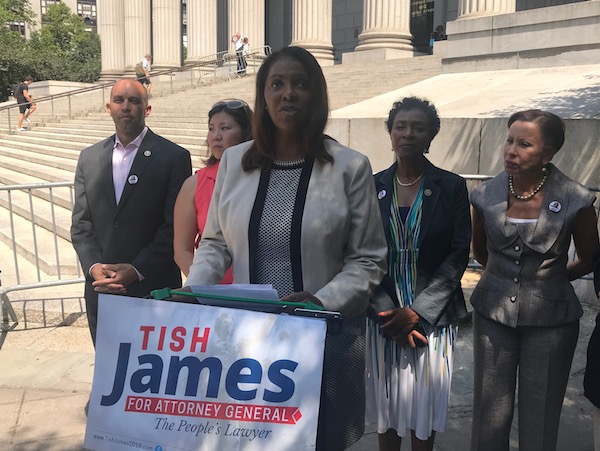
Letitia James, the author (photo: Gotham Gazette)
Wall Street malfeasance has had devastating consequences in New York State. It precipitated the foreclosure crisis, in which tens of thousands of families lost their homes, others faced an unrecovered loss in property values, and many jobs were lost. Ten years later, the Trump Administration and the Republican Congress are weakening oversight by federal agencies by watering down the Dodd-Frank Act and undermining the Consumer Finance Protection Bureau (CFPB).
Today, Wall Street securities valuations are, by all accounts, exceedingly high, corporate borrowing is excessive, and monetary policy still encourages risk. Fueled by predatory companies, student debt, and institutional greed, United States household debt has now grown to $13.39 trillion. Corporations are issuing debt again with fervor, and dark pools for trading securities still proliferate. We once again see flawed stock research, mortgage backed securities and other collateralized debt with sophisticated and troubling capital tranches. High-speed trading is prominent, and illegal front-running practices are still threats to our markets and society.
In this current booming economy, the Trump Administration has shown unsurprising short-sightedness and a remarkable short-term memory. The economy will inevitably ebb and flow, yet instead of bolstering safeguards, the federal government is rolling back the very protections and regulations established after the Great Recession. In taking aim at the protections--like the Volcker rule--contained in the Dodd-Frank Wall Street and Consumer Protection Act, the Republican Party is once again proving that it cares more about appeasing corporations than it does about protecting Americans from another financial crisis.
Fortunately, in New York, we have the most important prosecutorial power in the nation to stem malfeasance, protect our markets, and hold those who violate the law accountable: the Martin Act. The Martin Act grants investigatory and enforcement powers to the New York Attorney General, who is entrusted to enforce our state’s banking laws. Everyday, many millions of Americans rely on our state’s Attorney General to fully and judiciously use laws like the Martin Act to hold bad actors accountable and to prevent firms from defrauding the public.
As the next New York Attorney General, I will aggressively pursue these cases, and will use the Martin Act to the fullest extent possible.
Using the tools of the office, including subpoena power, I will investigate and watch over Wall Street. I will conduct data-driven investigations. I will bring cases, and seek injunctive relief to protect consumers, seek restitution for New Yorkers who have lost hard-earned money, and fight for wholesale policy changes.
I will stand up to the Trump Administration that seeks to pre-empt the Martin Act, protecting a critical power that fights Wall Street malfeasance. I will work collaboratively with the state Legislature to re-establish a six-year statute of limitations that recently was limited by the New York State Court of Appeals, ensuring that bad actors don’t go unpunished simply because the clock runs out. I will also work to increase criminal penalties for violations of the Martin Act, to mandate sentencing of perpetrators as larcenies of up to 25 years in prison. I will ensure that the Investor Protection Bureau has the necessary resources and support to expand.
Not since the time of Attorney General Jacob Javits in 1955, when criminal penalties were added by the Legislature, will there be a more committed champion of change. I will be the Attorney General conceived of in law, not just rhetoric.
For everyone on Wall Street to Main Street, let me be clear: as New York State Attorney General, I will use the considerable power of New York state laws to scrutinize those practices and industries that have benefited from deregulation under Trump, and those that are currently posing a significant threat to our economy. Unfettered greed that results in foreseeable losses that devastate the lives of ordinary and sometimes unwitting investors is actionable, and New Yorkers can count on me to take legal action.
***
Letitia “Tish” James is the New York City Public Advocate and a Democratic candidate for New York Attorney General. On Twitter @TishJames.
***
Have an op-ed idea or submission for Gotham Gazette? Email This email address is being protected from spambots. You need JavaScript enabled to view it.
Running for Attorney General, James Takes Strong Atlantic Yards Record Too Far
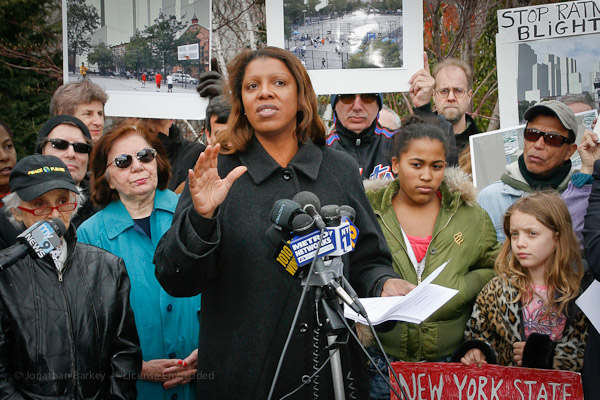
James at a 2007 press conference announcing a lawsuit challenging the environmental review of Atlantic Yards - she was not a plaintiff or attorney in the case (photo ©Jonathan Barkey)
A May Politico profile of New York City Public Advocate Letitia (Tish) James, the front-runner in the upcoming election for state Attorney General, noted that “she has occasionally shown a flair for exaggeration, which has periodically raised questions about her credibility.” Cited were statements about her age and her claim of credit for a New York Times series on homelessness.
Indeed, I’ve witnessed such exaggeration. Perhaps it’s carelessness, coupled with confidence in her undeniable charisma. Perhaps it relates to James’ alternative career choice of the ministry (as she once told an interviewer), in which parable can trump precision. But as James moves up the professional ladder, such hyperbole gets more hazardous, especially as she asks voters to make her the state’s top legal officer.
So it was surprising and dismaying to hear James during two recent appearances inflate her significant and often brave record opposing the Atlantic Yards project, the arena-plus-towers development announced in 2003 when she was representing the 35th City Council District in Brooklyn.
As the project’s leading political opponent, she asked tough questions at City Council hearings, sponsored an alternative plan for the Vanderbilt Yard, and stood up for residents threatened by eminent domain or denied promised construction jobs. She doesn’t need to overstate her role challenging the political firmament. (Her campaign, informed of examples to be outlined in this column, declined to comment on the record.)
James’ new posture seems politically expedient, since, as I wrote in May 2016, James actually has taken a softer stand in recent years, willing to call a reporter after being nudged by the original project developer, the politically powerful Forest City Ratner. (The project was in 2014 renamed Pacific Park.)
Taking Atlantic Yards to the U.S. Supreme Court?
At the August 15 Democratic attorney general candidate forum sponsored by Indivisible Harlem (at about 55:20 remaining on this video) James responded to a question about the city’s investigation of yeshivas said to be offering an inadequate secular education and got on a riff that segued to Atlantic Yards.
“Lastly, let me just say that I’m the only individual on this stage that’s actually taken a major developer all the way to the United States Supreme Court, and almost bankrupted him, is Letitia James. We took a developer [who wanted] to build a basketball arena for the worst team in the NBA, and engaged in foreclosing upon homes. And I’ll always remember, as a City Council member who looked in the eyes of someone who was a Holocaust survivor”—
The moderator intervened, reminding James that the question concerned yeshivas.
James was unbowed: “So it’s about yeshivas, and about a Holocaust survivor. And that Holocaust survivor said, ‘Tish, stand up and fight back.’ We’ll fight back and make sure yeshivas are educating individuals and we’re going to fight back against abuses by developers in the city of New York and the state of New York. And we’re going to stand up against corruption in the state of New York.”
Hold on. The federal eminent domain case, Goldstein v. Pataki, which James helped herald at an initial press conference, was rejected at the trial court and appellate court levels. Then the plaintiffs asked the Supreme Court to hear it; the Court refused, as it does most petitions. (A companion case was then filed in state court.)
So, while the case was brought to the Supreme Court, it wasn’t heard by the Supreme Court. More importantly, Council Member James as an individual played, at best, a supporting role. She was neither named plaintiff nor participating lawyer.
Checking a few details
Did that case “almost bankrupt” Forest City Ratner and developer Bruce Ratner? That’s a bit of a stretch, though Atlantic Yards -- conceived in optimistic times before the recession -- certainly caused major financial pain.
Also, neither Forest City Ratner nor Empire State Development, the state authority overseeing and shepherding the project, were "foreclosing on homes," or taking homes from borrowers in default. James would better have said that, with the threat of eminent domain, the developer was squeezing—and buying, with significant public dollars—people out of their homes.
A Holocaust story
What about that Holocaust survivor? James at least once has dubiously expanded that reference, as I wrote in September 2012, as the Barclays Center was opening, about a TV interview with James.
"The issue is really about standing up and advocating for your community...against the abuse of all is right,” she said. “This woman I know, and I'll always remember her, lived in footprint, she was a Holocaust survivor. She wanted to die in her home. She was 89 years old. She should've been allowed to die in her home and not suffer under the stress of being subject to eminent domain for a basketball arena."
I checked with two people who should know, and was told the elderly Holocaust survivor who was stressed by eminent domain was a commercial tenant, not a residential one. No one remembers -- and I asked again this week -- a residential tenant who was a Holocaust survivor.
Yes, an elderly woman in the footprint, Victoria Harmon, didn't want to move, and did end up dying at home, but she wasn’t a Holocaust survivor.
Repeating the eminent domain claim
This past Tuesday, during a Democratic attorney general candidate debate that aired on Manhattan Neighborhood Network, James brought up Atlantic Yards again.
“I took that [eminent domain] case all the way to the Supreme Court," she said at one point, soon amending the claim to “We."
As I wrote on Twitter, James deserves credit for promoting or participating in several Atlantic Yards cases, such as the environmental review case (in the photo at top), but not the claim as stated.
She was a named plaintiff in two lawsuits: one challenging the Metropolitan Transportation Authority’s willingness to relax a deal with developer Forest City Ratner, and another challenging the state’s 2009 re-approval of the project, which ultimately led a judge to criticize Empire State Development, the state authority overseeing the project, and to order a new environmental review.
Was my criticism, as one James supporter tweeted, “strangely nitpicky”? I don’t think so, especially if it’s part of a pattern.
A Prospect Park fable
James also exaggerated in her statement at a April 30 public hearing concerning a controversial two-tower project near Atlantic Terminal in Brooklyn called 80 Flatbush.
“So, we should not block the clock,” said James, referring to the widespread belief that the towers—one stretching 986 feet tall—would block views of the four-sided clock of the Williamsburgh Savings Bank tower, now known as One Hanson. (Neighborhood opponents say the clock will be blocked from the west; the environmental review says it won’t.)
“We should respect the lady, the Williamsburgh Bank building, which is an icon,” James continued. “And again, as someone who was born and raised in Brooklyn, when I would get lost in Prospect Park, I would always look to the Williamsburgh Bank building for direction and purpose and a sense of who I am and what I believe in.”
Really? The landmarked tower rises 512 feet. You can’t see near it from the biggest clearing (the Longmeadow) inside Prospect Park; that intersection is just too far away. The places where one might be lost, even in decades past, would further scotch sightlines. (By the way, if you walk up Flatbush Avenue a few blocks today and look northwest toward the bank, the clock is already blocked by a tower flanking the Barclays Center, 461 Dean.)
James had ample reasons to be wary of 80 Flatbush, notably what Assemblymember Jo Anne Simon and state Senator Velmanette Montgomery have called the request for an “unprecedented” tripling of allowable density. But James went beyond criticism to fable.
***
Norman Oder is a Brooklyn journalist who writes the watchdog blog Atlantic Yards/Pacific Park Report. On Twitter @AYReport.
***
Have an op-ed idea or submission for Gotham Gazette? Email This email address is being protected from spambots. You need JavaScript enabled to view it.
Term Limits and Other Community Board Reforms Strengthen Local Democracy
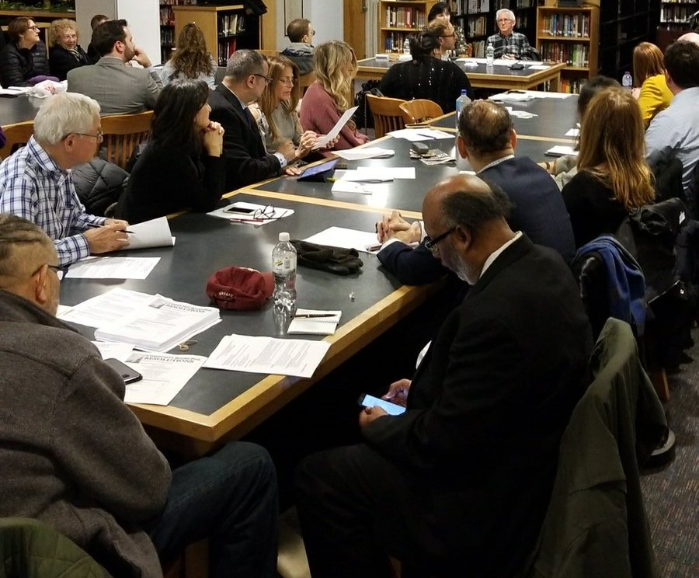
A Manhattan community board meeting (photo: @ManhattanCB5)
Community boards are our most participatory, hyper-local form of government in New York City. In November, we will have the chance to vote for necessary reforms that will help ensure our community boards represent the diverse perspectives of our communities. These reforms will likely include term limits for community board members, greater transparency in the appointment process, and better technical assistance for community board members to make fully informed decisions. They will be put before voters as a result of Mayor de Blasio’s Charter Revision Commission; exact ballot language is due early next month.
As a member of my own Community Board 2 in Queens since April 2017, I have seen the need to open up our community boards, and I urge you to support these measures in November.
Our community boards play a crucial role in shaping the development of our neighborhoods, advising elected officials and agencies on the delivery of city services, and communicating with the broader community at large. To that end, it is crucial that community board membership look, feel, and think with the diverse perspectives that make up each community. It is essential that people of varied backgrounds -- professional, racial, ethnic, and otherwise -- are able to represent their neighborhoods.
Term limits, while not a panacea for better board representation, will help ensure that turnover on the community boards ushers in diverse voices that too often get crowded out when there aren’t many vacancies on boards. True diversity and genuine community representation on community boards can contribute to better city services. After all, community boards whose membership consists of a more holistic cross-section of the community will be in a better position to accurately advise city agencies and local elected officials on the efficacy of city services and additional needs that exist throughout a given community board district.
Board members who are term-limited, as I hope to be one day, can continue to serve in other vital capacities: civic associations, parks conservancies, tenant groups, are just a few of the ways that everyone in the community can participate. This is, of course, in addition to attending community board meetings and speaking at the public comment section, which is open to everyone, including former board members.
The appointment process itself is also in dire need of reform. Board applications should ask not just for character references and organizational affiliation, but also ask applicants about their community knowledge, overall civic participation, and other skills that will be valuable to the boards. This allows board members to be appointed who may not have ties to political offices or previous knowledge about the complex application process. Further, community board membership should be evaluated to assess for diversity among members. Boards that reflect the communities they serve will be stronger and more robust, able to accomplish more for our neighbors.
We also need better technical assistance on the boards to help make objective, thoughtful decisions and requests when crucial issues come before us. This is especially true on matters of public safety and critical land use decisions.
Community boards serve an important purpose. Board members hold city agencies and locally elected officials accountable to local needs. From sidewalk cafes to bike lanes to liquor licenses, community boards touch on everyday life for all New Yorkers. That’s why it’s so critical to open up the process of applying to the community board, and make sure that borough presidents and City Council members place a premium on selecting board members from a broader swath of the community. Join me in November to support these reforms.
***
Jeremy Rosenberg is a community activist, attorney, and member of Community Board 2 which serves Sunnyside,Woodside, and Long Island City. Reach him on Twitter at @jeremyr1992.
***
Have an op-ed idea or submission for Gotham Gazette? Email This email address is being protected from spambots. You need JavaScript enabled to view it.
Why We Wore ‘Abolish ICE’ Shirts to the Statue of Liberty

the author, Tiffany Huang, and her partner (photo: Sy Klipsch-Abudu of NYCLU)
Two months ago, my partner gifted me tickets for a Statue of Liberty tour. Despite growing up near New York and living in the city for the last two years, I had yet to visit the statue itself, and was excited to make the trip. For me and many others, the Statue of Liberty is a symbol of welcome to immigrants and refugees to the United States.
As our July tour date approached, however, the news roiled with ever-more-horrifying reports about family separation and child detention, brought about by the Trump administration’s “zero-tolerance” immigration policy. These horrors were fresh, but not altogether new. Although the United States has indeed served as a beacon of welcome and refuge for many immigrants over the centuries, it has not always lived up to that ideal. From the Chinese Exclusion Act of 1882, to the (anti-immigration) Immigration Act of 1924, to Operation Wetback in the 1950s, this country has at times enacted ugly, racist policies that excluded people from the U.S. on the basis of race and national origin.
We are in the midst of one of those periods. Under the Trump administration, Immigration and Customs Enforcement (ICE) has become an agent of toxic anti-immigrant action. Their “zero-tolerance” policy has led to human rights abuses that have horrified onlookers both in the U.S. and around the world. While the Trump administration has since ended the practice of family separation, more than 500 children remain separated from their families. ICE has deported 460 parents without their children. The trauma that these families have experienced will endure far past this moment.
When we were preparing to go on our Statue of Liberty tour, we felt compelled to raise attention to the contradiction between what the statue symbolizes and the reality of our present politics. We therefore chose to wear shirts that read “Abolish ICE.” For us, “Abolish ICE” is a call to acknowledge the abuses of current immigration policy, and to rebuild our broken immigration system.
When we arrived at the tour’s embarkation point, however, security personnel stopped us and demanded that we either change our shirts, or leave the tour. Although we insisted that we had no plans for disruptive action -- and indeed, we did not -- they held firm. We opted to leave the tour, but later contacted the New York Civil Liberties Union (NYCLU) about the incident. The National Park Service has since admitted that it was a mistake to bar us from the tour because of our shirts, which were simply and obviously an expression of free speech.
We are grateful that the U.S. Park Police has acknowledged its error. But to us, the bigger story is the injustice that the Trump administration continues to perpetrate on immigrant communities. As the Statue of Liberty stands in the New York Harbor, we as a nation must stand up for what she symbolizes.
***
Tiffany J. Huang is a graduate student at Columbia University. On Twitter @tiffjhuang.
***
Have an op-ed idea or submission for Gotham Gazette? Email This email address is being protected from spambots. You need JavaScript enabled to view it.
Unraveling the New York Nuclear Subsidy Scam
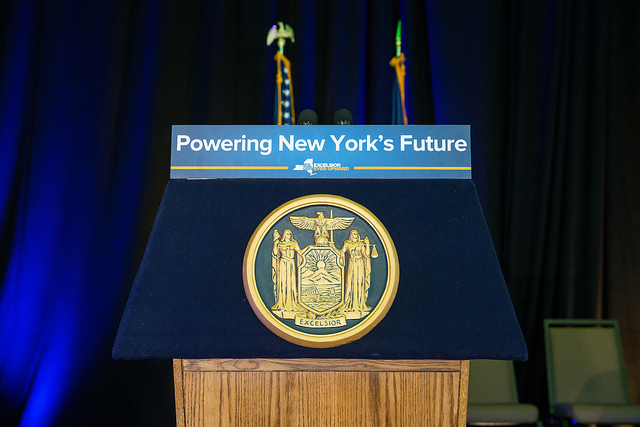
(Photo via the Governor's Office)
Across the country, nuclear plant owners are insisting states and the federal government approve billion-dollar subsidies to bail them out -- even if they’re profitable. In its 2016 Clean Energy Standard (CES), the New York State Public Service Commission quietly authorized charging ratepayers up to $7.6 billion over 12 years on their electric bills to subsidize nuclear giant Exelon, so it would keep running upstate nuclear plants it threatened to close (FitzPatrick, Ginna, and Nine Mile Point). Since these surcharges kicked in last spring, New Yorkers have already handed over $656 million and counting to prop up these failing nuclear plants.
The nuclear subsidy scam started in New York, and it's getting exported. After they were imposed here, Exelon and other nuclear owners used the same playbook to obtain billions more in subsidies in Illinois ($2.4 billion), New Jersey ($3.6 billion), Connecticut (estimated up to $3 billion), and soon, Pennsylvania and other states. They did it by falsely claiming their nuclear plants are “clean energy” and “zero emissions,” and threatening to shutter them and terminate their workers if they don’t get the money, escalating their lobbying activity all the while.
Such tactics shouldn’t work, yet they do. For example, in New Jersey Exelon and PSEG threatened to close plants and spent a combined $2.6 million last year on lobbyists, who kept dogging the New Jersey legislature until the unpopular subsidy package finally passed.
To date, the fairness and legality of these subsidies have not been challenged and judged in court. But that’s about to change. A suit in New York State Supreme Court (Matter of Hudson River Sloop Clearwater v. NYS Public Service Commission, Albany County, 7242-16) is finally examining whether these subsidies are illegal or improper, if they violate the public trust and due process of law, and if PSC overstepped its authority by granting them without due process. The suit, of which I am a plaintiff, survived motions to dismiss, and hearings are pending which will have far-reaching implications.
New York is where the nuclear subsidy trend started. The PSC sold subsidies as a way to preserve jobs and “carbon-free” power as a kind of radioactive “bridge” to developing renewables. Now the New York State Supreme Court could be where those specious arguments unravel.
Dirty, obsolete nuclear plants are neither “clean energy” nor “zero emissions” and don’t deserve “zero emissions credits.” Subsidizing them squanders billions that won’t be invested in renewables or efficiency, the two best ways to lower greenhouse emissions and fight climate change. In its first year, New York’s Clean Energy Standard spent 99.5% of its money to subsidize nuclear plants, and just 0.5% on renewables.
Nuclear subsidies aren’t a public good, but a private wealth transfer, enriching wealthy nuclear owners at ratepayers’ expense. As Illinois subsidies kicked in this year, Exelon Generations’ earnings growth shot from 8% to a cork-popping 36%. In New Jersey, the Salem and Hope Creek nuclear plants obtained ratepayer subsidies, yet they’re profitable and will remain so at least through 2021. Nuclear owner PSEG’s CEO admitted to The Bergen Record the subsidy was calculated to guarantee an 18% profit -- almost double the average return for a regulated utility in New Jersey.
Could it be that behind such greedy profiteering is an enlightened desire on the part of nuclear owners to save us from climate change or preserve local jobs and tax bases? Is it unfair to accuse them of ratepayer money grabs?
Hardly. A March 2017 presentation by a former Exelon lobbyist that recently resurfaced brags about its nuclear subsidies representing a huge return on its “investment” in lobbying and political influence. One slide asked rhetorically, “Is Politics Profitable?,” and answers by comparing Exelon’s outlays in New York for the FitzPatrick plant, capital expenditures, and lobbying and PR campaigns to the $7.6 billion it got back in subsidies. It boasts that represented a “return on investment” of 750%. An image on the slide showed copious amounts of cash spiraling down a vortex.
That image is emblematic of what’s wrong with these subsidies: lobbying and politicking for profit, dumping billions in ratepayers’ money down the drain to enrich wealthy plant owners, instead of investing in renewables and efficiency. Those are the real issues, and as the New York State Supreme Court lawsuit goes to trial this year, they will finally get heard.
***
Tim Judson is the Executive Director of the Nuclear Information and Resource Service (NIRS), one of the plaintiffs in the New York lawsuit.
***
Have an op-ed idea or submission for Gotham Gazette? Email This email address is being protected from spambots. You need JavaScript enabled to view it.
Providing Stronger Support for Breastfeeding Mothers in New York City
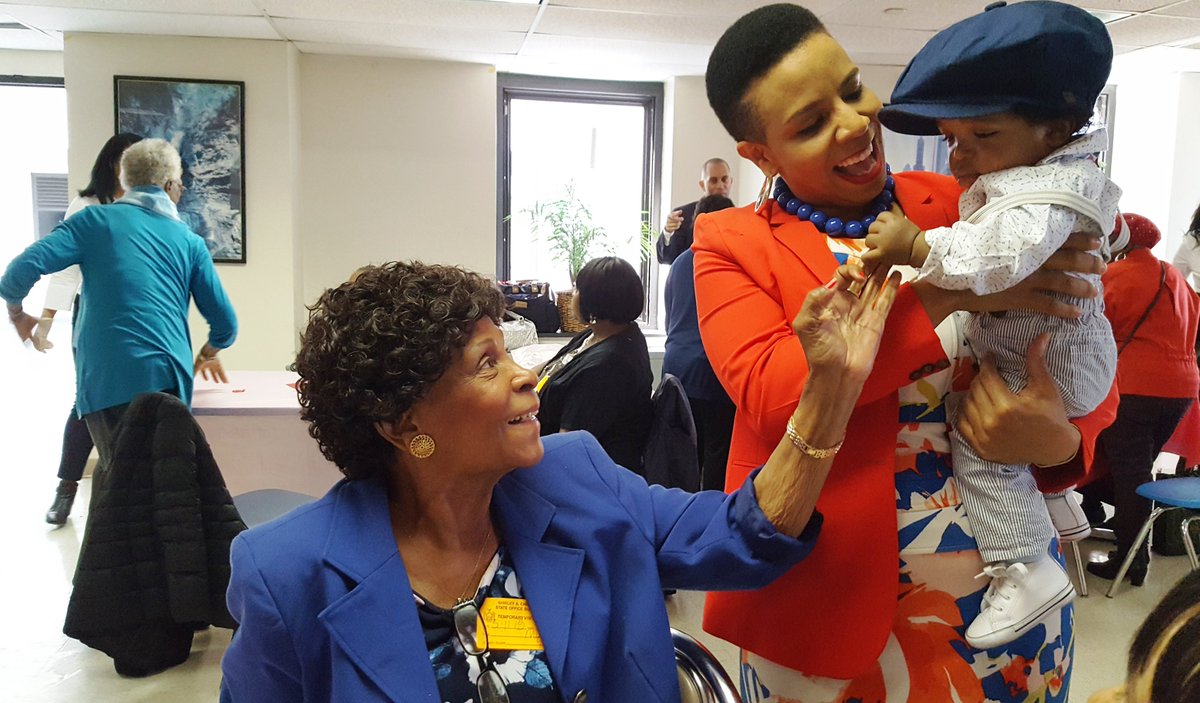
Council Member Laurie Cumbo, the author (right), with her son, Prince (photo:@cmlauriecumbo)
If we are truly committed to the health, well-being, and economic advancement of mothers and babies, we must examine our public spaces, work places, and cultural biases when it comes to supporting and accommodating a mother’s choice to breastfeed. As of only a few weeks ago, mothers can now breastfeed legally in all 50 states without fear of violating laws pertaining to indecent exposure or public obscenity. This is a low bar for celebration, and cause for a critical examination of our own local laws and societal norms.
The benefits of breastfeeding are long-known and widely accepted in the medical community – the World Health Organization recommends that babies are breastfed for at least the first six months of their lives. The health benefits for babies include lower rates of obesity, SIDS, asthma, and other conditions, and can even be traced to higher IQs. For mothers, breastfeeding lowers the risk of type 2 diabetes, and certain types of ovarian and breast cancers. It is for these reasons, and for the purpose of defending a mother’s right to choose what they do with their bodies and how they take care of their children, that we must remain diligent in our efforts to identify and break down any barriers for mothers who choose to breastfeed.
Those of us holding elected office must all leverage our positions and platforms to advance breastfeeding rights and awareness. We must make sure that mothers know all the facts about breastfeeding, what they are entitled to and what resources are available to them, should they choose to breastfeed.
Here, in New York, we have strong laws and we are increasing our investment at the state and local level in support of breastfeeding mothers. I am proud to have made breastfeeding rights a focal point of my time in office, with legislation advancing greater education and access for those who need to breastfeed or express milk in public or in the workplace. Right now, the Mother’s Day Legislative Package, which I was proud to spearhead on my very own first Mother’s Day, has pending legislation that will expand accommodations for breastfeeding mothers in certain city spaces and in workplaces, as well as establish a standard lactation accommodation policy. I thank my colleagues, Council Members Robert Cornegy and Carlina Rivera, for their leadership and partnership on these breastfeeding bills. I am committed to seeing through these efforts and ensuring that our physical structures reflect our values of equity and inclusion.
As a mother of a now one-year-old myself, I have a new appreciation for and understanding of the literal and figurative structures that play a role in the lives of New York mothers. From pre-natal care to childbirth and child rearing, there is a culture of expectation that women are just supposed to know how to take care of themselves and their children based on instinct alone. Far too many women are not getting the resources they need. Further, as recent research has shown, health concerns expressed during childbirth are often not taken seriously, resulting in a much higher mortality rates for black and Latina women. The truth is, we all need guidance and support throughout the pregnancy, birthing and nurturing process, which is why we must continue to expand and center the needs of mothers in public and working spaces. Every mother is different, as is every child, and our ultimate goal should be to support and uplift all mothers, regardless of whether they choose to breastfeed.
One personal breastfeeding experience of note was when I was able to use one of the Department of Health’s “lactation pods” at Brooklyn Children’s Museum. What struck me about my experience was how welcoming the environment was. Breastfeeding is often framed as an inconvenience, but in this instance, I felt proud and encouraged. The unfortunate reality is that this is an uncommon experience for breastfeeding mothers. More often than not, new mothers in the workplace have to seek out any space they can find — some report even having to pump in a closet. This is inexcusable and detrimental to the dignity and well-being of working mothers everywhere.
It is going to take a dedicated, comprehensive approach and a fundamental reimagining of working motherhood, but I know that we can achieve it. Moms continue to show up for each other, time and time again, but it is time we show up for them. We must stand with them and do everything in our power as individuals and as a collective society to better support their needs. Breastfeeding takes a village. It is a mental, physical, emotional, and logistical act. August is National Breastfeeding Awareness month, and so there is no better time than now to commit to a better tomorrow for mothers and children in New York City.
***
Laurie Cumbo is the majority leader of the New York City Council. She represents Brooklyn communities of Fort Greene, Clinton Hill, Prospect Heights and parts of Crown Heights and Bedford-Stuyvesant. On Twitter @cmlauriecumbo.
***
Have an op-ed idea or submission for Gotham Gazette? Email This email address is being protected from spambots. You need JavaScript enabled to view it.
New Research Shows SHSAT Less Valuable Predictor Than Middle School Grades
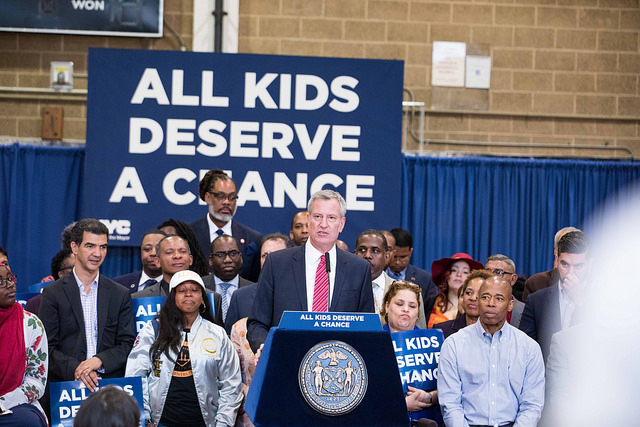
Mayor de Blasio's announcement on specialized high schools (photo: Benjamin Kanter/Mayor's Office)
The recently-released Metis validation study of the Specialized High School Admissions Test has portrayed the SHSAT in a more favorable light than the facts warrant.
Although Metis found that SHSAT scores were correlated with high school grades, it did not investigate whether other factors might be stronger predictors. In my validation study, the most important finding was that seventh grade GPA predicts more than twice as much of the variance in high school grades (44%) when compared to the SHSAT, which predicted 20% in my study and 21% in the Metis study. This finding is critical to the current debate over the admission system at New York City’s Specialized High Schools.
Mayor Bill de Blasio, along with many advocates and civil rights groups, have proposed doing away with the test, with a three-year phase-out period where the test is used along with grades for admissions purposes. Their opponents have argued that allowing grades as a factor would dilute the quality of the students admitted and thus the quality of these schools, an argument that is rebutted by my analysis.
This study uses data supplied by the New York City Department of Education, including the 27,818 SHSAT scores from 2013, and grades for New York City public school students in that cohort.
The chart below compares mean SHSAT scores for students at Stuyvesant High School with their Freshman Grade Point average (FGPA) in different FGPA categories. Students with FGPAs below 75 actually had higher SHSAT scores than students with FGPAs from 75 to 85, while students with FGPAs of 85 to 90 had barely higher scores. Only the students with grades above 95 had much higher scores. This suggests that the exam does not predict very well for students with scores below the very top.
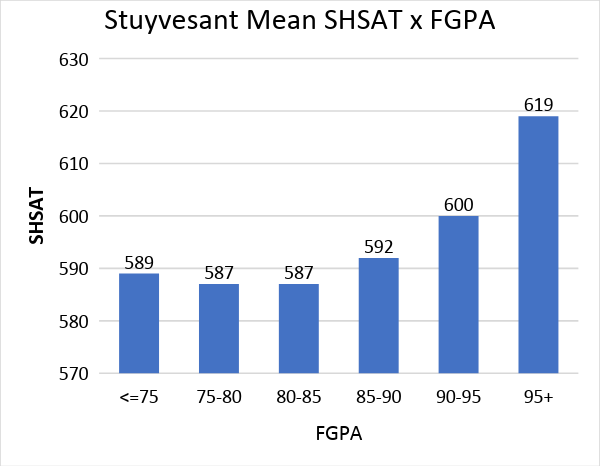
The next chart, which compares the same categories of FGPA by seventh grade GPA (GPA7) of Stuyvesant students, instead of their SHSAT scores, shows a much more linear relationship. Higher FGPAs were associated with higher GPA7 in a regular progression.
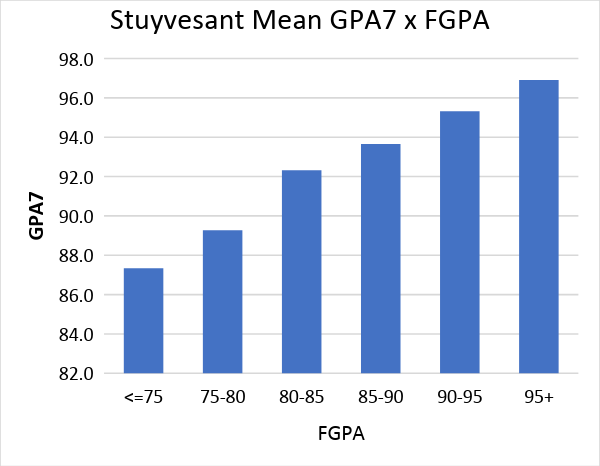
As is well known, girls are admitted to the specialized high schools at much lower rates than boys. Below is the chart with the rates by gender for those students who took the test last year, when girls represented 51% of applicants and only 44% of those admitted.
A good study of predictive validity should address the gender bias of the exam. According to American Educational Research Association standards, the test user is “responsible for evaluating the possibility of differential prediction for relevant subgroups for which there is prior evidence or theory suggesting differential prediction.” Prior evidence with respect to the validity of the SAT suggests that possibility. Yet, the Metis study failed to do this, despite the fact that girls are under-represented in the Specialized High Schools.
In my study, girls had lower SHSAT scores than boys with the same GPA. For example, at Stuyvesant High School, girls had GPAs equal to GPAs of boys whose SHSAT scores were 6 to 7 points higher. The following chart shows that girls (red bars) achieved each FGPA level with lower SHSAT scores than boys (blue bars). Among students in 95+ FGPA group, girls (549) had mean SHSAT scores 16 points lower than boys (565). This chart helps explain why fewer girls are admitted to the Specialized High Schools than boys.

The gender bias of the SHSAT parallels findings with respect to the predictive validity of the SAT. However, there is a crucial difference in how the scores are used. The SAT is only one of multiple criteria considered in college admissions, including high school grades, which enables admissions officers to take that statistical bias into account. In New York City, where the SHSAT is the sole admissions criterion for eight schools, girls with lower SHSAT scores than boys are denied admission despite the fact that they are expected to do as well as boys admitted with higher scores. It is clear that as the sole admissions criterion to the Specialized High Schools, the SHSAT is unfair to girls.
A variety of analyses were done to rule out the possibility that the under-prediction in girls’ grades resulted from differences in course selection. Because the under-representation of females in STEM majors and occupations has been a source of societal concern, it was of special importance to examine the relationship between SHSAT scores and girls’ grades in STEM areas, and to ascertain whether girls in New York City’s Specialized High Schools enroll as frequently and do as well as boys in challenging STEM courses.
Gender comparisons were done across different academic domains for all students who took the SHSAT in 2013 and subsequently attended New York City high schools. Similar comparisons were done for those who actually attended Specialized High Schools. Finally, analyses were done at Stuyvesant High School, which, because it is the most selective of the schools, might possibly have the most difficult courses. Overall, girls earned significantly higher grades than boys in each of these categories. At the Specialized High Schools, girls had higher mean STEM grades (89.6) than boys (86.7) and enrolled in STEM courses in proportion to their overall numbers in these elite schools.
Grades in specific courses offer the best test of the hypothesis that girls are less capable of succeeding in STEM subjects, and that the under-prediction of their grades by standardized tests such as the SHSAT is due to enrollment in easier courses. At Stuyvesant High School, girls, on average, earned better grades than boys in each of the ten specific STEM courses analyzed, including Geometry, Integrated Algebra, Biology, and Physics. In four of the ten courses, girls were represented in greater numbers than in the overall Stuyvesant ninth grade cohort. Furthermore, their grades were significantly under-predicted by the SHSAT.
In 2005, Lawrence Summers, then president of Harvard, suggested that the reason there were fewer women in STEM fields was their under-representation at the highest level of the distribution of ability in STEM subjects. Because one of the goals of the Specialized High School admissions process is to identify truly exceptional students, it is important to determine if the higher mean grades earned by girls in STEM classes were achieved without those extreme high-achievers. It would be possible for girls to have higher mean grades, but fewer exceptional grades. However, this is not the case. Girls represented only 42% of the cohort and only 41% of the top 3% of SHSAT scores, but in STEM courses they earned 50% of the grades of 95 or better, and only 30% of grades 80 or lower.
Why should females earn better grades than predicted by their performance on the SHSAT and SAT? Research has repeatedly shown that women do poorly relative to men on multiple choice questions. In addition to the SAT, this phenomenon has been found on a wide range of exams, including AP exams, placement exams, and the California State Bar Exam. One researcher attributed this to women on average being more risk-averse, and therefore not guessing as often as males, although guessing on multiple choice tests is often a useful strategy.
Because women often outperform men on constructed answer questions, it seems possible that multiple choice and constructed answer questions tap different competencies on which there are real gender differences. Constructed answer questions, particularly essays, may require multiple abilities, and may reflect a more complex understanding of material than do questions that require only the selection of a correct choice. If multiple choice and open constructed answer questions measure important, but different abilities, in the interest of fairness, exams should include both types of questions. Given that the purpose of the SHSAT is to admit a class with the greatest chance of success at school, it is apparent that the same metric cannot be used for boys and girls, and that the exam should be reformulated to include questions in different formats.
Our analysis also found that New York state exams were somewhat less gender-biased than the SHSAT, and somewhat more predictive of success in high school, perhaps because they contain more open-constructed answer questions, though again, 7th grade GPA is the most valid predictive factor for success at New York City high schools in general, including the Specialized High Schools.
A hypothetical admissions index was constructed weighting SHSAT and GPA7 by coefficients from the regression of FGPA. The index was then used to simulate admissions to the Specialized High Schools, resulting in the proportion of girls “admitted” rising from 45% to 62%, a difference of 716 girls. At Stuyvesant, using the index, the representation of girls increased from 44% to 65%, a difference of 177 girls. If GPA7 were the sole admissions criterion, the proportion of girls would have been 68%, a difference of 202 girls.
Use of this index would also have resulted in substantially different racial/ethnic proportions. At Stuyvesant, for example, an additional 10 African-American and 25 Hispanic students would have been admitted. Asian students, though reduced in numbers from 78% would still comprise 66% of those admitted. Similar shifts would occur in the entire cohort of students admitted to Specialized High Schools, with increases of 40 African-American, 209 Hispanic, and 205 white students. With 49% of the hypothetically admitted class, Asian students would still constitute the largest segment and would be admitted in numbers far exceeding their proportion of applicants (32%).
Because the hypothetical criterion predicts far more variance in FGPA than the actual criterion, with a smaller standard error of estimate, its use should not dilute the quality of the entering class. In fact, it might even result in a stronger cohort, while simultaneously increasing diversity and gender equity.
With changes to the SHSAT and consideration of additional criteria, it may be possible to select a group of students who will be more representative of the community the school system serves, and the pool of students who apply, without sacrificing the excellence for which New York City’s Specialized High Schools are so justifiably famous.
***
Jonathan Taylor, Ph.D. is an educational research analyst.
***
Have an op-ed idea or submission for Gotham Gazette? Email This email address is being protected from spambots. You need JavaScript enabled to view it.





